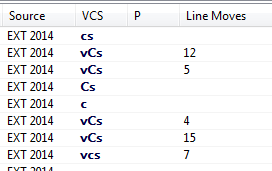|
Games list |

|

|
|
|
Games list |

|

|
Games list
The list window has a number of tabs at the top which take you to the different indexes for the games of the database.
The other indexes are all described in their own sections:
| • | Game Title A new Index. |
Optional Theme keys for tactics, strategy, endgames and general themes.

Naturally the games list is the most frequently used window type in the Database window. You use it to browse a database, a search result, contents of an openings key, game of a player and so on. Please try to understand how to configure a games list, it will considerably increase the usability of the program for you. Other lists (players, tournaments) work the same.

Right clicking on the list window and selecting List Format – Columns – All Columns turns on the display of all the available columns for the list.

Above the list important functions to process the information in the list is available in Ribbons. This means that all the most important functions are available by simple mouse clicks.

In every list there is an extensive right click menu with functions that depend on whether one or several games have been selected.
Example Selecting games: Clicking two games while holding the shift key selects all the games that lie between them.

Clicking two games while holding the control key selects two individual games.
In the games list, you can see the game numbers, names of the players, their ratings (which may be left out if there is too little space in the list), the tournament, round and the annotator (in square brackets).
Behind this you will sometimes find “medals”, a coloured band which helps to characterise the game.
The next columns give the ECO code, date, result and number of moves. On the right is a column that tells you what the game contains:
V = the game contains variations (alternate lines)
C = the game contains text commentary
A = it contains graphic annotations (coloured squares and arrows)
F = the game contains correspondence chess commentary
I = critical positions (special annotation) are marked in the game
T = the game contains training commentary
S = the game contains commentary symbols (!, !?, etc.)
G = another game is quoted in the notation
R = a “repertoire” game
M = the game contains multimedia elements (sound, pictures, videos)
P = the game starts from an entered position (studies, problems)
The above letters may also be small, if the variations, commentary, etc. are not extensive.

For instance “Vcs” means a lot of variations, but relatively little text commentary and Symbol commentaries.